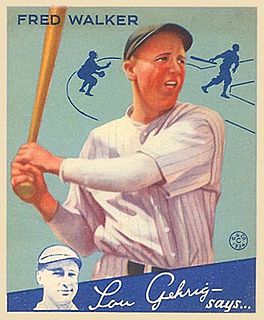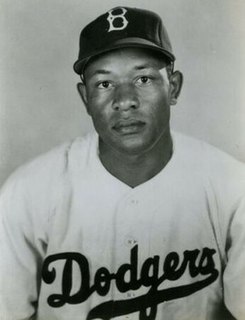Related Research Articles
The Negro leagues were United States professional baseball leagues comprising teams of African Americans and, to a lesser extent, Latin Americans. The term may be used broadly to include professional black teams outside the leagues and it may be used narrowly for the seven relatively successful leagues beginning in 1920 that are sometimes termed "Negro Major Leagues".

Oscar McKinley Charleston was an American center fielder and manager in Negro league baseball. Over his 43-year baseball career, Charleston played or managed with more than a dozen teams, including the Homestead Grays and the Pittsburgh Crawfords, Negro league baseball's leading teams in the 1930s. He also played nine winter seasons in Cuba and in numerous exhibition games against white major leaguers. He was inducted into the National Baseball Hall of Fame in 1976.

Wesley Branch Rickey was an American baseball player and sports executive. Rickey was instrumental in breaking Major League Baseball's color barrier by signing black player Jackie Robinson. He also created the framework for the modern minor league farm system, encouraged the Major Leagues to add new teams through his involvement in the proposed Continental League, and introduced the batting helmet. He was posthumously elected to the Baseball Hall of Fame in 1967.
The first Negro National League (NNL) was one of the several Negro leagues that were established during the period in the United States when organized baseball was segregated. The league was formed in 1920 with former player Rube Foster as its president.
The second Negro National League was one of the several Negro leagues that were established during the period in the United States when organized baseball was segregated. The league was founded in 1933 by businessman Gus Greenlee of Pittsburgh.

The Kansas City Monarchs were the longest-running franchise in the history of baseball's Negro leagues. Operating in Kansas City, Missouri, and owned by J. L. Wilkinson, they were charter members of the Negro National League from 1920 to 1930. J. L. Wilkinson was the first Caucasian owner at the time of the establishment of the team. In 1930, the Monarchs became the first professional baseball team to use a portable lighting system which was transported from game to game in trucks to play games at night, five years before any major league team did. The Monarchs won ten league championships before integration, and triumphed in the first Negro League World Series in 1924. The Monarchs had only one season in which they did not have a winning record. The team produced more major league players than any other Negro league franchise. It was disbanded in 1965.

William Julius "Judy" Johnson was an American professional third baseman and manager whose career in Negro league baseball spanned 17 seasons, from 1921 to 1937. Slight of build, Johnson never developed as a power threat but achieved his greatest success as a contact hitter and an intuitive defenseman. Johnson is regarded as one of the greatest third basemen of the Negro leagues. In 1975, he was elected into the Baseball Hall of Fame after being nominated by the Negro Leagues Committee.

Fred E. "Dixie" Walker was an American professional baseball player, coach, scout and minor league manager. He played as a right fielder in Major League Baseball from 1931 to 1949. Although Walker was a five-time All-Star selection, and won a National League batting championship (1944) as well as an RBI championship (1945) as a member of the Brooklyn Dodgers, his accomplishments as a player were overshadowed by his attempt to keep Jackie Robinson from joining the Dodgers in 1947. He also played for the New York Yankees, Chicago White Sox, Detroit Tigers and Pittsburgh Pirates.

Clyde Leroy Sukeforth, nicknamed "Sukey", was an American professional baseball catcher, coach, scout and manager. He was best known for signing the first black player in the modern era of Major League Baseball (MLB), Jackie Robinson, after Robinson was scouted by Tom Greenwade in the Negro leagues.

Elwood "Bingo" DeMoss was a baseball player and manager in the Negro leagues from 1905 to 1943.

Raymond Hall Hayworth was an American professional baseball player, manager and scout. He played as a catcher in Major League Baseball between 1926 and 1945, most notably as a member of the Detroit Tigers team that won two consecutive American League pennants in 1934 and 1935 and won the 1935 World Series. He was employed in professional baseball for nearly 50 years from 1926 to 1973.

William Augustus Greenlee was a highly successful businessman in Pittsburgh, Pennsylvania, who was born and raised in Marion, North Carolina. After migrating to Pittsburgh as a young man and working in the steel industry, he started to acquire his own businesses.
The Nashua Dodgers was a farm club of the Brooklyn Dodgers, operating in the class-B New England League between 1946 and 1949. It is believed to be the first professional baseball team based in the United States in the twentieth century to play with a racially integrated roster. The team was based at Holman Stadium in Nashua, New Hampshire.

Daniel Robert Bankhead was the first African American pitcher in Major League Baseball. He played in Negro league baseball for the Birmingham Black Barons and the Memphis Red Sox from 1940 to 1947, then played for the Brooklyn Dodgers from 1947 to 1951.
The following is a timeline of franchise evolution in Major League Baseball. The histories of franchises in the National Association of Base Ball Players (NABBP), National Association of Professional Base Ball Players (NA), Union Association (UA), and American Association (AA) before they joined the National League are also included. In 1900 the minor league Western League renamed itself the American League (AL). All of the 1899 Western League teams were a part of the transformation with the Saint Paul Apostles moving to Chicago and to play as the White Stockings. In 1901 the AL declared itself a Major League. For its inaugural major league season the AL dropped its teams in Indianapolis, Buffalo and Minneapolis and replaced them with franchises in Boston, Philadelphia, and Baltimore and the Kansas City Blues moved to Washington to play as the Senators.

John Richard Wright was a Negro league pitcher who played briefly in the International League of baseball's minor leagues in 1946, and was on the roster of the Montreal Royals at the same time as Jackie Robinson, making him a plausible candidate to have broken the baseball color barrier. Instead, Wright was demoted from Montreal and returned the next season to the Negro leagues.

Wendell Smith was an African American sportswriter who was influential in the choice of Jackie Robinson to become the first African American player in Major League Baseball in the 20th century.
Bradford Bennett, was an American Negro league outfielder, first baseman and second baseman active in the 1940s.
The Cleveland Clippers were a Negro league baseball team in the minor United States League, based in Cleveland, Ohio in 1946. Composed mostly of former players on from the Great Lakes Naval Varsity team and local sandlot stars, the Clippers are credited with a 2–16 record in 18 league games. By July, the Clippers had folded and the remnants of the organization merged with the Brooklyn Brown Dodgers.
The Brooklyn Brown Dodgers were a Negro league baseball team from 1945 to 1946. Calling Ebbets Field home, they played primarily in the United States League and folded with the rest of the league in 1946.
References
- ↑ "Branch Rickey". Encyclopaedia Britannica. Retrieved 17 November 2019.
- ↑ "United States League (1945-1946)" (PDF). Center for Negro League Baseball Research. Retrieved 17 November 2019.